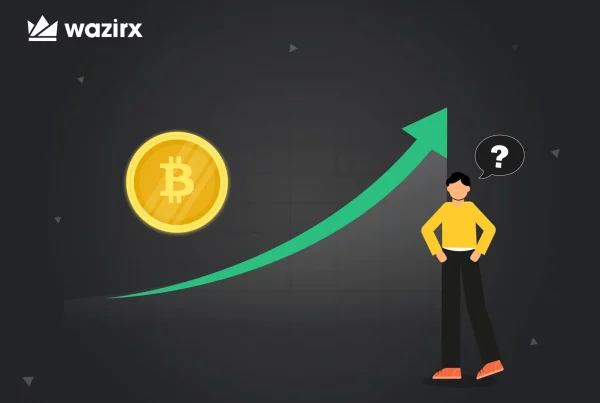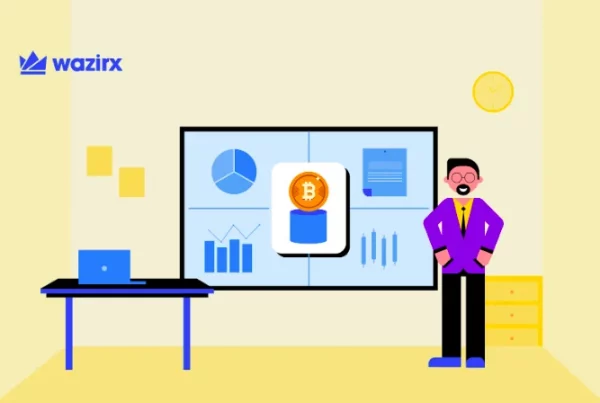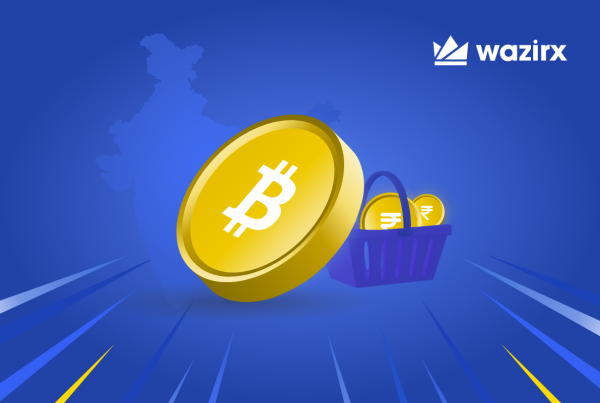Table of Contents
BRC-20 is an experimental token standard; it allows the minting and transferring of fungible tokens using the Ordinals protocol on the Bitcoin blockchain.
Taking inspiration from Ethereum’s ERC-20 tokens, BRC-20 tokens have their own mechanisms and functionalities. Despite being extremely popular in the first half of 2023, BRC-20 tokens are still in their early stages, and users should proceed with the utmost caution.
In this article, let’s have an overview of BRC-20 tokens and how they are different from ERC-20 tokens.
Overview of the BRC-20 token and its working
BRC-20 tokens were proposed in March 2023 by an anonymous developer named Domo, and they are designed to follow the model of Ethereum’s ERC-20 token standard. BRC-20 tokens utilize Ordinal inscriptions to facilitate the creation and transfer of fungible tokens on the Bitcoin blockchain. A token standard consists of a set of rules that govern the operation of the tokens it creates. For example, ERC-20 is the token standard for creating tokens on the Ethereum blockchain. However, unlike ERC-20, the Bitcoin BRC-20 standard is still in its early stage and has not yet been officially approved.
Initially, Bitcoin was created as a decentralized peer-to-peer currency, lacking the ability to deploy smart contracts or other decentralized applications. However, the Bitcoin Taproot upgrade in 2021 introduced the capability to include additional data in Bitcoin block space using the Ordinal protocol. This development paved the way for the emergence of Bitcoin NFTs (Nonfungible Tokens) and the development of BRC-20 tokens. The Ordinal protocol involves assigning a serial number to each Satoshi (the smallest unit of Bitcoin) and including them in Bitcoin transactions along with Ordinal data.
BRC-20 tokens incorporate JavaScript Object Notation (JSON) within the Ordinal inscriptions to define and initialize the functionality of token smart contracts. This enables users to deploy, create, and transfer tokens on the Bitcoin network.
[wd_hustle id="4" type="embedded"/]Now, let’s see some of the advantages and disadvantages of BRC-20 tokens.
What are the advantages and disadvantages of BRC-20 tokens?
Advantages
There are several advantages of BRC-20 tokens that have contributed to their popularity in such a short time.
- Compatibility with the Bitcoin network:
The compatibility with the Bitcoin network is a key advantage of the BRC-20 standard, as it allows seamless integration of Bitcoin Ordinals and BRC-20 tokens into the Bitcoin blockchain. This feature enables the standard to leverage the robustness and wide acceptance of the network, facilitating its widespread adoption within the Bitcoin community. Additionally, it leverages the network’s existing infrastructure, including wallets and exchanges, further contributing to its rapid acceptance.
- Simplicity:
The BRC-20 token standard employs a simplified mechanism for tokenization, making it user-friendly and easy to use. Unlike other token standards that rely on complex smart contracts, the BRC-20 standard avoids the need for intricate configurations. This simplicity empowers users to mint and transfer BRC-20 tokens without requiring specialized technical expertise.
- Security:
The BRC-20 token standard ensures exceptional security by leveraging the inherent robustness of the Bitcoin blockchain. Bitcoin’s decentralized nature, algorithmic technologies, and proof-of-work consensus mechanism contribute to the system’s overall security. By utilizing the Bitcoin blockchain, the BRC-20 standard capitalizes on these security mechanisms, safeguarding the integrity of its tokens.
- Better potential for growth:
With increasing adoption by various projects, the BRC-20 standard is poised to drive innovation and introduce novel use cases. This, combined with the extensive and diverse network user base, is likely to attract the attention of developers, investors, and users, promoting the expansion and maturation of the BRC-20 token standard over time.
Disadvantages
Since the BRC-20 tokens are still in their early stage, there are possibilities that they also have some limitations. So let’s check them out.
- No smart contract functionality:
In contrast to token standards like Ethereum’s ERC-20, the BRC-20 standard doesn’t support smart contracts. Smart contracts are blocks of code that expand the range of capabilities on compatible blockchains. They can be configured to enhance automation, transparency, security, and asset management. The absence of smart contract support in the BRC-20 standard may limit its potential in certain areas where smart contracts are beneficial.
- Dependency on the Bitcoin blockchain:
The BRC-20 standard relies on the Bitcoin blockchain, which exposes it to the inherent limitations of the network. These limitations include low scalability and slow transaction speeds. As the utility of the BRC-20 blockchain increases and congestion worsens, these issues are likely to become more prominent. Network congestion has worsened since the standard’s launch, leading to a significant increase in Bitcoin Ordinals. This influx has caused longer transaction processing times and higher network fees. Consequently, the efficiency and cost-effectiveness of BRC-20 token transfers may be negatively affected as the problem persists.
- Limited interoperability:
The BRC-20 token standard is specifically designed to operate within the Bitcoin blockchain ecosystem. This characteristic presents challenges in terms of interoperability, especially for users who intend to utilize alternative blockchain systems. The absence of this feature on the BTC network limits seamless token transfers across different blockchain networks within the crypto ecosystem. This restriction hinders users from leveraging cheaper and more efficient networks when it is convenient.
- Limited utility:
The BRC-20 standard is primarily suited for the tokenization of fungible assets. It is not well-suited for tokenizing nonfungible assets or implementing complex token features like tokenized ownership rights or conditional transfers. Projects that require more specialized tokenization functionalities beyond the capabilities of the BRC-20 standard are likely to seek more comprehensive token standards that offer richer features.
Until now, you must have got a fair idea of how BRC-20 tokens differ from ERC-20 tokens. But below is a comparison between the two in tabular form.
Difference between BRC-20 and ERC-20 tokens
| BRC-20 Tokens | ERC-20 Tokens |
| They are related to the Bitcoin network. | They are related to the Ethereum network. |
| They have limited functionality as they aren’t smart contract compatible. | They can interact with other chains and protocols because of their smart contract compatibilities. |
| The market cap is close to $450 million. | The market cap is above $150 billion. |
| They follow the Proof-of-Work (PoW) consensus mechanism. | They follow Proof-of-Stake (PoS) consensus mechanism. |
| Ordiscan is used to track the movement of BRC-20 Ordinals and inscriptions. | Etherscan is used to track the movement of ERC-20. |
Final thoughts
In conclusion, BRC-20 tokens may unlock new doors for DeFi projects and applications in the Bitcoin ecosystem with future development and integrations. However, the technology is still in its experimental stages; therefore, there are chances of potential challenges. Consequently, market liquidity should be regularly monitored, portfolios should be diversified, and risk management techniques should be used.
Frequently Asked Questions
Is Pi Cryptocurrency Safe?
Pi Network captured the crypto community’s interest even before it officially debuted. Its innovative mobile mining approach and user-friendly design simplify crypto adoption for a broader audience. Some users see this as a chance to get engaged in the crypto from the beginning and profit in the future, similar to how early Bitcoin adopters made huge profits by mining and keeping the coin. Other users have compared Pi to a worthless multi-level marketing (MLM) scheme.
Which Cryptocurrency Is Best To Invest In 2021?
Many altcoins are flourishing to invest in. Some cryptocurrencies with great potential are Ether, Ripple, Tron, and more. Investors are trying to diversify their portfolios and are flocking to the leading cryptocurrencies. Many growing businesses are already accepting cryptocurrency as acceptable payment methods.
Is Ethereum Safe To Invest?
The Bitcoin market is unquestionably more volatile than the stock market. This may not be the market for you if you are incredibly risk-averse. Ethereum, on the other hand, may be a terrific investment for you if you're a diamond-handed investor who won't lose sight of short-term losses. Ethereum is a relatively safe investment as it is also based on blockchain.
What Is Virtual Currency?
Virtual currency is a type of uncontrolled digital currency that can only be used online. It is exclusively stored and transacted using designated software, mobile or computer applications, or unique digital wallets, and all transactions are conducted through secure, dedicated networks. Because digital currency is just currency issued by a bank in digital form, virtual currency is not the same as a digital currency. Virtual currency, unlike ordinary money, is based on a trust structure and cannot be issued by a central bank or other banking regulatory organization.
What Is The Meaning Of Crypto?
A cryptocurrency is a digital currency that is secured by the process of cryptography, making counterfeiting and double-spending almost impossible to happen. Blockchain technology is used to produce cryptocurrencies ( a distributed ledger enforced by a distributed network of computers). Cryptocurrencies are distinct in that a centralized authority does not issue them.
How Many Cryptocurrencies Are There?
There are over 5000 other digital currencies available on the internet in addition to Bitcoins. The only problem is that they haven't gotten the users' attention. Besides Bitcoins, a few other digital currencies have gained popularity among users. It's been more than ten years since Bitcoins were first released, and now they've achieved new heights thanks to their phenomenal success.
What Are The Best Cryptocurrencies To Invest In?
The best cryptocurrencies to invest in would be the ones you study and analyze in detail. Some of the most popular cryptocurrencies include Bitcoin, Ethereum, and many altcoins such as Tron, Ripple, Litecoin, etc.
Who Invented Cryptocurrency?
Satoshi Nakamoto invented cryptocurrencies and the technology that makes them function in 2009. The presumed pseudonymous individual or persons who invented Bitcoin used this identity. In addition, Nakamoto created the first blockchain database. Even though many people have claimed to be Satoshi Nakamoto, the person's identity remains unknown.
How Safe Are Cryptocurrencies?
Cryptocurrencies can be safe, but your crypto wallets can be hacked if proper security steps are not performed. There are also dangers and uncertainties associated with investments, and we cannot declare any virtual currency investment risk-free. Buying and selling cryptocurrencies does not have to be dangerous if the trader is well-versed in the market and treats his coins with care.
Is Crypto Legal In India?
Cryptocurrencies are legal in India, and anyone can purchase, sell, and exchange them. It is currently uncontrolled, as India lacks a regulatory structure to oversee its operations. Per the Ministry of Corporate Affairs, companies must now record their crypto trading/investments within the financial year. In cases where a person receiving the gains is an Indian tax resident, or the cryptocurrency is regarded as domiciled in India, cryptocurrency transactions have been taxable in India
 Disclaimer: Cryptocurrency is not a legal tender and is currently unregulated. Kindly ensure that you undertake sufficient risk assessment when trading cryptocurrencies as they are often subject to high price volatility. The information provided in this section doesn't represent any investment advice or WazirX's official position. WazirX reserves the right in its sole discretion to amend or change this blog post at any time and for any reasons without prior notice.
Disclaimer: Cryptocurrency is not a legal tender and is currently unregulated. Kindly ensure that you undertake sufficient risk assessment when trading cryptocurrencies as they are often subject to high price volatility. The information provided in this section doesn't represent any investment advice or WazirX's official position. WazirX reserves the right in its sole discretion to amend or change this blog post at any time and for any reasons without prior notice.










